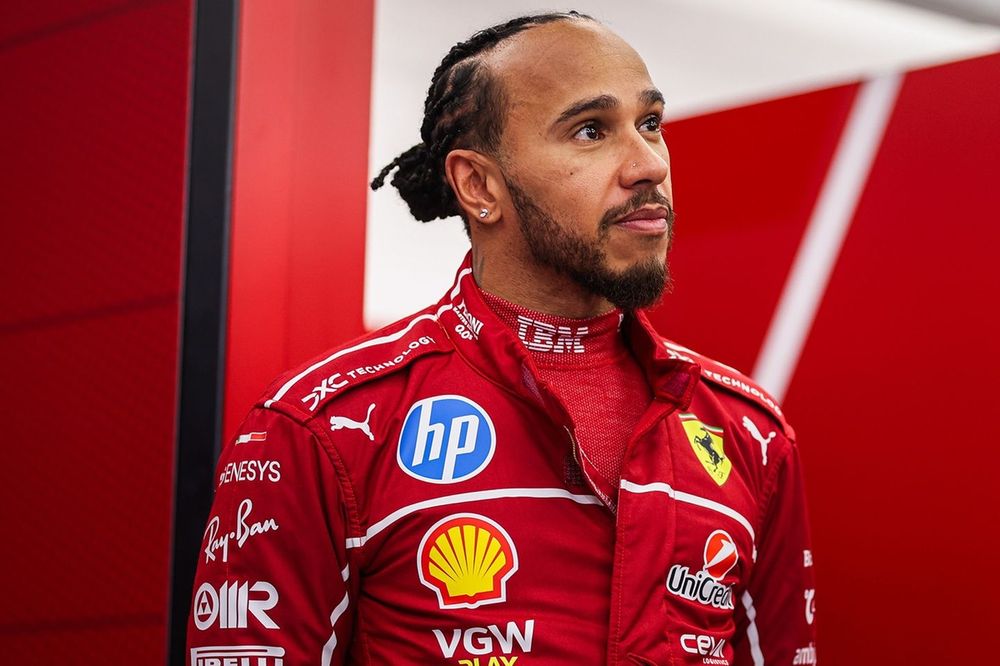Hamilton Drops a Bombshell: Ferrari’s Secret Struggle Exposed After Japanese Grand Prix
Lewis Hamilton has once again shaken the Formula 1 world — but this time, it wasn’t with a daring overtake or a record-breaking lap. Following a difficult weekend at the Japanese Grand Prix, the seven-time world champion made headlines with candid post-race revelations that have sent shockwaves through the paddock.
Hamilton, who is still settling into life at Ferrari, exposed a critical flaw in his SF25 car that has hampered his performance since the start of the season. His comments, direct and unfiltered, served as a wake-up call to Ferrari management: if they want to compete at the sharp end of the grid, urgent changes are needed.

What makes Hamilton’s disclosure even more alarming is the timing. We’re only a few races into the season, and the pressure is already mounting. Expectations were sky-high when Hamilton made his blockbuster move to Ferrari, and fans hoped to see immediate success. Instead, he’s grappling with a persistent issue unique to his side of the garage — a technical problem that has kept him off the pace while teammate Charles Leclerc consistently finishes ahead.
At Suzuka, Hamilton crossed the line in a frustrating P7, trailing both Mercedes cars and far from podium contention. Speaking openly after the race, he admitted that a particular component of his SF25 has been underperforming since the opening round. While he stopped short of naming the exact part, it was clear from his tone that this isn’t a minor gripe — it’s a serious performance blocker.
“With what I had, that’s the best result I could get,” Hamilton confessed, underlining just how constrained he felt during the race. Coming from a driver who has built a career on extracting every ounce of performance from his machinery, this admission carried weight. It wasn’t about adaptation or learning the new car; this was a fundamental technical limitation.
Through the early part of the season, observers speculated that Hamilton’s struggles might stem from adjusting to Ferrari’s handling characteristics or syncing with his new engineering team. However, his comments have dispelled that notion. The problem lies not with the driver, but with the machine.

Adding to the challenge, Ferrari has been forced to compromise their setup due to regulatory concerns. Following Hamilton’s disqualification in Shanghai for excessive plank wear, the team raised the ride height of the SF25 to avoid further penalties. While this protected them from scrutiny, it also cost them dearly in aerodynamic performance, especially on fast, flowing circuits like Suzuka.
While Leclerc has managed to adapt to this less-than-ideal setup, Hamilton has battled with understeer, reduced rear stability, and a narrow operating window — all critical drawbacks when trying to fight off rivals like Red Bull, McLaren, and Mercedes.
The silver lining? Ferrari has reportedly identified the problem. Hamilton hinted that the team is working on a solution and hopes to have it addressed before the next race. But, as every seasoned F1 fan knows, diagnosing an issue is just the beginning. Implementing a fix under the relentless pressures of the F1 calendar is an entirely different challenge.
Hamilton’s frustration is understandable. He didn’t join Ferrari to play catch-up. His goal is clear: to win races and pursue an unprecedented eighth world title. But right now, by Hamilton’s own admission, Ferrari is the fourth-best team on the grid, trailing Red Bull, McLaren, and Mercedes.

Hamilton also highlighted the need for continuous development, warning that unless Ferrari steps up its upgrade game, they risk falling even further behind. In a sport where tenths of a second make all the difference, Hamilton estimates that Ferrari is currently losing three to four-tenths per lap to the leading teams — a massive margin at this level of competition.
His public critique sends a clear signal to Ferrari’s leadership and technical team: step up, or risk squandering the potential of one of the sport’s greatest talents. Hamilton’s transparency, rare in the usually guarded world of F1, underscores the urgency of the situation.
For Ferrari, the ball is now firmly in their court. Can they provide Hamilton with a car capable of fighting at the front? Can they close the performance gap not only between them and their rivals but also internally, between Hamilton and Leclerc?
If they succeed, Hamilton’s dream of winning with the Prancing Horse could still come true. But if they fail, this chapter in Hamilton’s storied career could turn from hopeful to heartbreaking.
Either way, this drama is far from over. As Hamilton’s journey with Ferrari continues to unfold, one thing is certain: the 2025 season promises to be one of the most gripping in recent memory.